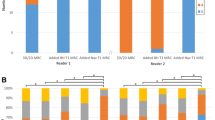Abstract
Purpose
To investigate whether the addition of gadolinium ethoxybenzyl diethylenetriamine pentaacetic acid (Gd-EOB-DTPA)-enhanced 3D T1-weighted MR cholangiography (T1w-MRC) to 3D T2-weighted MRC (T2w-MRC) improves the confidence and diagnostic accuracy of biliary anatomy in living liver donors.
Methods
Two abdominal radiologists retrospectively and independently reviewed pre-operative MR studies in 58 consecutive living liver donors. The second-order bile duct visualization on T1w- and T2w-MRC images was rated on a 4-point scale. The readers also independently recorded the biliary anatomy and their diagnostic confidence using (1) combined T1w- and T2w-MRC, and (2) T2w-MRC. In the 23 right lobe donors, the biliary anatomy at imaging and the imaging-predicted number of duct orifices at surgery were compared to intra-operative findings.
Results
T1w-MRC had a higher proportion of excellent visualization than T2w-MRC, 66% vs. 45% for reader 1 and 60% vs. 31% for reader 2. The median confidence score for biliary anatomy diagnosis was significantly higher with combined T1w- and T2w-MRC than T2w-MRC alone for both readers (Reader 1: 3 vs. 2, p < 0.001; Reader 2: 3 vs. 1, p < 0.001). Compared to intra-operative findings, the accuracy of imaging-predicted number of duct orifices using combined T1w-and T2w-MRC was significantly higher than that using T2w-MRC alone (p = 0.034 for reader 1, p = 0.0082 for reader 2).
Conclusion
The addition of Gd-EOB-DTPA-enhanced 3D T1w-MRC to 3D T2w-MRC improves second-order bile duct visualization and increases the confidence in biliary anatomy diagnosis and the accuracy in the imaging-predicted number of duct orifices acquired during right lobe harvesting.




Similar content being viewed by others
References
Bhatti AB, et al. (2015) Quality of life after living donor hepatectomy for liver transplantation. World J Surg 39(9):2300–2305
Ladner DP, et al. (2015) Long-term quality of life after liver donation in the adult to adult living donor liver transplantation cohort study (A2ALL). J Hepatol 62(2):346–353
Xu D-W, Long X-D, Xia Q (2015) A review of life quality in living donors after living transplantation. Int J Clin Exp Med 8(1):20–26
Olthoff KM, et al. (2005) Outcomes of 385 adult-to-adult living donor liver transplant recipients. Ann Surg 242(3):314–325
Suh K-S, et al. (2015) Recent advancements in and views on the donor operation in living donor liver transplantation: a single-center study of 886 patients over 13 years. Liver Transpl 21(3):329–338
Parikh ND, Ladner D, Abecassis M, Butt Z (2010) Quality of life for donors after living donor liver transplantation: a review of the literature. Liver Transpl 16(12):1352–1358
Hoehn RS, et al. (2014) Comparing living donor and deceased donor liver transplantation: a matched national analysis from 2007 to 2012. Liver Transpl 20(11):1347–1355
Mortele KJ, Ros PR (2001) Anatomic variants of the biliary tree: MR cholangiographic findings and clinical applications. AJR Am J Roentgenol 177(2):389–394
Catalano OA, et al. (2008) Vascular and biliary variants in the liver: implications for liver surgery. RadioGraphics 28(2):259–278
Brown RS, et al. (2003) A survey of liver transplantation from living adult donors in the United States. N Engl J Med 348(9):818–825
Kochhar G, Parungao JM, Hanouneh IA, Parsi MA (2013) Biliary complications following liver transplantation. World J Gastroenterol 19(19):2841–2846
Umeshita K, et al. (2003) Operative morbidity of living liver donors in Japan. Lancet 362(9385):687–690
Kinner S, et al. (2014) Comparison of different magnetic resonance cholangiography techniques in living liver donors including Gd-EOB-DTPA enhanced T1-weighted sequences. PLoS One 9(11):e113882
Lim JS, et al. (2008) MR cholangiography for evaluation of hilar branching anatomy in transplantation of the right hepatic lobe from a living donor. AJR 191(2):537–545
Ragab A, Lopez-Soler RI, Oto A, Testa G (2013) Correlation between 3D-MRCP and intra-operative findings in right liver donors. Hepatobiliary Surg Nutr 2(1):7–13
An SK, et al. (2006) Gadobenate dimeglumine-enhanced liver MRI as the sole preoperative imaging technique: a prospective study of living liver donors. AJR 187(5):1223–1233
Lee MS, et al. (2011) Gadoxetic acid disodium-enhanced magnetic resonance imaging for biliary and vascular evaluations in preoperative living liver donors: comparison with gadobenate dimelumine-enhanced MRI. J Magn Reson Imaging 33(1):149–159
Mangold S, et al. (2012) MRI for evaluation of potential living liver donors: a new approach including contrast-enhanced magnetic resonance cholangiography. Abdom Imaging 37(2):244–251
Puente SG, Bannura GC (1983) Radiological anatomy of the biliary tract: variations and congenital abnormalities. World J Surg 7(2):271–276
Kim SY, et al. (2010) Biliary tract depiction in living potential liver donors: intraindividual comparison of MR cholangiography at 3.0 and 1.5 T. Radiology 254(2):469–478
Author information
Authors and Affiliations
Corresponding author
Ethics declarations
Conflict of interest
Larry Cai, Benjamin Yeh, Antonio C Westphalen, John Roberts, and Zhen J. Wang declares no conflict of interests.
Ethical approval
All procedures performed in studies involving human participants were in accordance with the ethical standards of the institutional and/or national research committee and with the 1964 Helsinki declaration and its later amendments or comparable ethical standards.
Informed consent
This was a retrospective study approved by our Committee on Human Research. IRB approval was obtained for this study with waiver of informed consent.
Rights and permissions
About this article
Cite this article
Cai, L., Yeh, B.M., Westphalen, A.C. et al. 3D T2-weighted and Gd-EOB-DTPA-enhanced 3D T1-weighted MR cholangiography for evaluation of biliary anatomy in living liver donors. Abdom Radiol 42, 842–850 (2017). https://doi.org/10.1007/s00261-016-0936-z
Published:
Issue Date:
DOI: https://doi.org/10.1007/s00261-016-0936-z




